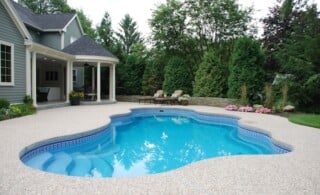
On average, homeowners spend between $800-$3000 installing, repairing, and replacing their vinyl inground pool liner. How do you end up at the low-cost end of the spectrum? You can significantly lengthen (or shorten) the life of your pool liner with your pool play and cleaning habits. And, if you practice proper maintenance and upkeep, your liner can last between 15-20 years.
Modern vinyl pool liners are meant to withstand the chemicals, tools, and the swimming and splashing bodies within its walls. Learning proper liner care will keep you from paying for costly repairs (or worse—having to spend as much as $4,100 to replace the entire liner). Here is a list of the top pool liner faux-pas and how you can maintain your liner for years to come.
- DIY installation
- Rips and tears
- Unbalanced pH levels
- Excess chlorine
- Non-pool toys in the pool
- Draining the pool
- Using household equipment as pool equipment
- Waterline neglect
DIY Installation
Vinyl liner is susceptible to costly rips, tears, and bubbles before installation. The task of installing the liner on your pool floor and walls is an incredibly trying task, and if installed incorrectly, can dramatically reduce your liner’s lifespan.
The material cost of in-ground pool liner is between $700 and $1,500. Vinyl for above ground pools is less costly, but can still range in price between $100 and $600. If you’re going to invest in something as expensive as pool liner, you may as well hire a professional who will correctly install the liner. You can find trustworthy installation pros near you at HomeAdvisor. Let them worry about smoothing out the bubbles and laying it flat! You get to enjoy the soft and smooth finished product.
Rips and Tears
When noticed, rips and tears in the pool liner should be taken care of immediately. Left open, those rips and tears can cause water leaks, which if left untreated can cause water to settle in the soil around your pool and cause it to shift, settle, and crack.
Unbalanced pH levels and Excess Chlorine
Swimming pools need chemicals added to keep them safe and sanitary. However, using too many chemicals, or putting them in the pool the wrong way, can significantly lessen the life of your liner. The two biggies for pool chemicals are chlorine and pH. With a few tips or adjustments to your chemical routine, you can get your liner in ship shape:
- Chlorine: Always dissolve in a bucket before adding it to the pool. If it comes in direct contact with the liner without being dissolved, it can bleach the liner and eat away at the material. If your pool is chlorine deficient, on the other hand, the liner will lose its shape as it wrinkles and shrinks.
- pH: Proper water chemistry will keep your pool liner healthy. pH levels should be between 7.4 and 7.6 and can be tested with chemical strips. Anything above 7.8 will cause calcium to form which mixes with existing dirt and sticks to the liner.
Non-Pool Toys
Pool toys are made with soft materials and are often inflatable. This is because it’s easy to tear the liner once you start adding plastic, stone, or wood material (anything with a sharp edge really). Hard materials and sharp edges aren’t meant for the pool environment and can create holes and tears if rubbed up against the liner. Liner tears need to be repaired immediately, and can cost upwards of $350. As much as your kids may want to play with their action figures in the pool, stick to pool noodles or rubber submarines instead.
Draining the Pool
Never completely drain a pool with vinyl lining. Vinyl is known to shrink, crack, and dry out if it is exposed to air. This is especially true of older liners, which become more brittle with age. If you want to clean the floor of the pool, leave at least 6 to 12 inches of water to help protect your liner.
Using Household Equipment as Pool Equipment
Household cleaning equipment and pool cleaning equipment are sold separately for good reason. Household cleaners and tools are meant for non-vinyl surfaces, and an innocent kitchen scrub brush could put a big hole through your vinyl. For the best results, use a pool vacuum meant for vinyl, and never use a pool pole with a metal end to scrape or clean the sides or floor of the pool. Vinyl friendly products only!
Waterline Neglect
This is especially important if you have a pool in a sunny state or locale. The sun wears down pool liners over time (if you do get a lot of sun, make sure to use a thicker vinyl from the beginning).
Wash the waterline area of the pool regularly with vinyl cleaner to prevent scum buildup and staining which can ruin the liner.
An pool is an investment. Taking these few steps to protect your pool liner and keep it clean can increase your pool’s lifespan and usability.
 Pros, Cons & Costs: Fiberglass Pools
Pros, Cons & Costs: Fiberglass Pools  Indoor Hot Tub: A Steamy Situation
Indoor Hot Tub: A Steamy Situation  Why Everybody Should Have a Pool Cleaner
Why Everybody Should Have a Pool Cleaner  Quick Tips for a Summer-Ready Pool
Quick Tips for a Summer-Ready Pool  Get in Shape with an Endless Pool
Get in Shape with an Endless Pool 

Are You Familiar With This Topic? Share Your Experience.